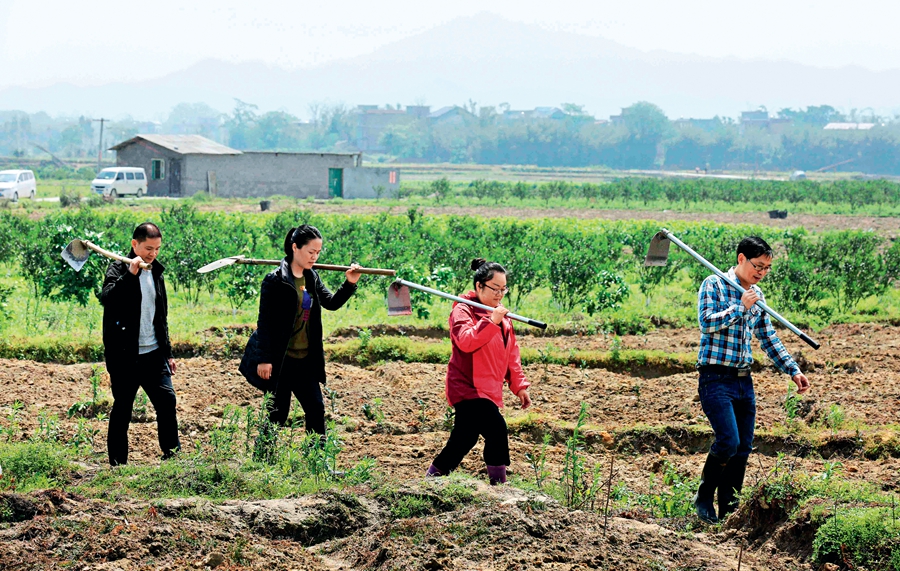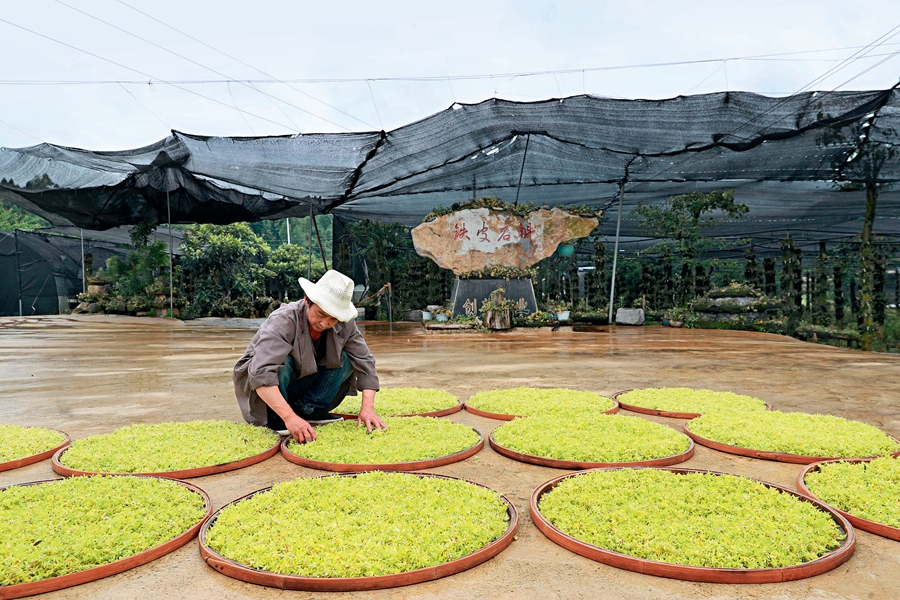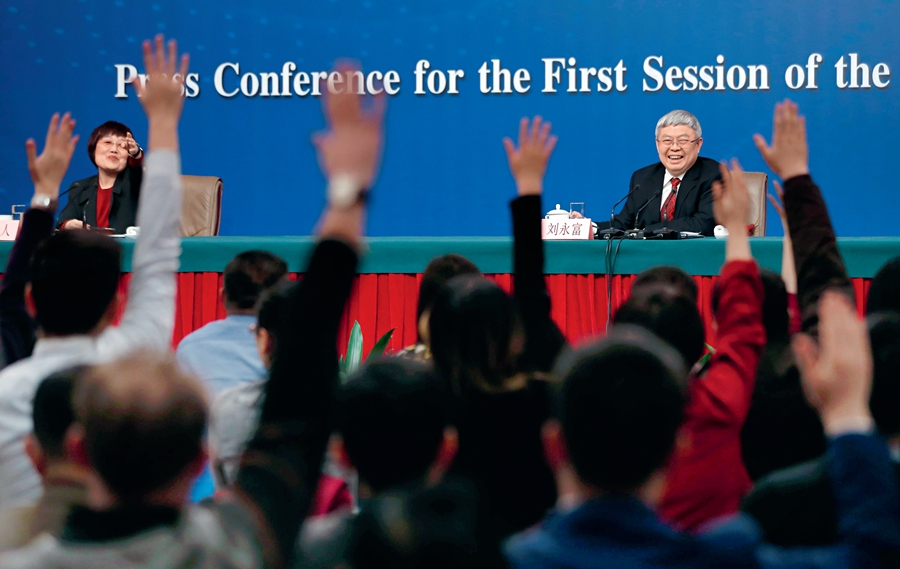SINCE China announced its goal to eradicate poverty in every corner, Chinese President Xi Jinping has emphasized that efforts should be devoted to solving concrete problems, and results be reported accurately. Xi stressed that only in this way, could the efforts truly gain public recognition and stand the test of time. Xi analyzed the issue from the perspectives of ensuring full and strict governance over the Party and modernizing the country’s system and capacity for governance and poverty reduction.

CPC members and cadres head for the fields to help plant kumquats in Hele Village of Rong’an County, Liuzhou City in Guangxi Zhuang Autonomous Region, on April 16, 2018.
In October 2017, at the 19th CPC National Congress, Xi drew a key conclusion that China had made decisive progress in its fight against poverty, and also stressed that poverty alleviation should be clearly aimed, and effective. In February 2018, on an investigation tour, Xi went to Liangshan Yi Autonomous Prefecture of Sichuan Province, which had long been trapped in dire poverty. Shortly afterwards, he chaired a seminar in Chengdu on targeted poverty alleviation, mapping out a plan for the next three years, requiring poverty reduction to be targeted, focused, rule-abiding, and subject to strict supervision. As to areas and people in desperate need, Xi said not a single village or citizen in extreme poverty should be left behind.
Xi’s talks and instructions on poverty alleviation serve as an important part of the Xi Jinping thought on poverty relief. They work as guidance to those who help combat rural poverty on the front lines.
In June 2018, the CPC Central Committee and the State Council issued instructions on how to wipe out poverty in the next three years. It aims to forge top-level design of poverty relief with detailed policy measures, while, being cognizant that the key always lies in implementation, which can be summarized as “four adherences,” “three transformations” and “two systems.”
Four Adherences Is a Prerequisite
First, current goals and criteria should be adhered to. China set the goal of lifting all poor people out of poverty by 2020 by ensuring them access to adequate food and clothing, compulsory education, and housing. This is formulated in accordance with national conditions.

Growers dry dendrobium (a huge genus of orchids) flowers at a planting base in Xinqi Village of Zhijin County, Guizhou Province on June 12, 2018.
Second, targeted measures in poverty alleviation should be taken. Xi Jinping called for relevant policies and programs to be tailored for the needs of individual families in conjunction with targeted funding and expert support, and to be pursued with a result-oriented effort. In light of this, various measures have been drawn up to help the rural poor, including developing local production and education, relocating villagers living in geologically hazardous areas, establishing a mechanism for ecological compensation, and guaranteeing a basic living standard for people unable to work. They are in line with local conditions and could help those in need in a workable way.
Third, a mechanism, in which the central government leads, heads of the Party committees and governments at each level assume the overall responsibility, and cities as well as counties implement workable measures, needs to be adhered to. Each one’s responsibilities should be clearly defined, and their actions need to be decisive and effective.
Fourth, the strengths of all sectors of society should be pooled together. Collaboration on poverty reduction between China’s western and eastern regions should be strengthened; fixed-point poverty alleviation should be carried out by government institutions; people from different sectors of society including the government and the market should be mobilized to work together for this mission. Besides, specialized poverty reduction funds in different industries need to be established.
Three Transformations Are Key Actions
First, regions affected by extreme poverty should be the top priority. The government will provide focused assistance, such as more favorable policies, to areas of extreme poverty.
Second, the results of poverty alleviation efforts, especially in the long run, should hold a high priority. Therefore, it’s important to help establish a solid foundation for the poor to gradually shake off poverty and not to return to poverty again. In this way, efforts should stand the testament of time and practice.
Third, the social security system needs to be improved to help the poor. Former attention was on developing local natural resources and industries as the main way towards poverty relief. Now an improved social security system targeting poor people in different conditions has been added on top of that. The combination is expected to help make the poverty reduction more effective.
Two Systems: Guarantees for Achieving the Goal
First is an improved system to implement targeted poverty relief measures. Files of every impoverished household need to be kept as a way to make sure that all those who qualify are in and those who don’t, are out. Besides, data sharing and analysis are important as they are a prerequisite for macroscopic decision making.
As to stationed government officials and working teams in the village, strict criteria should be followed in the selection, especially for the stationed Party committee leaders. Government officials selection and management, the correction of their working style, and insufficient support need to be addressed before they can fully leverage their strengths as expected.

Liu Yongfu, director of the State Council Leading Group Office of Poverty Alleviation and Development, answers poverty alleviation-related questions at the press conference of the first session of the 13th National People’s Congress on March 7, 2018.
When it comes to the implementation of targeted poverty alleviation measures, the aforementioned targeted and differentiated measures should be set as the core. For example, developing competitive industries to create jobs can help mobilize poor villagers to train their own skills, which is far better than seeing them wait passively for the allocation of funds and materials.
Besides, strict standards and procedures need to be applied to assess whether people are lifted out of poverty or not. For all the counties, villages, and populations that are just brought above the poverty line, the poverty alleviation efforts will not come to a halt to ensure that the success achieved is sustained.
Second is an improved assessment and supervision system. From 2018 on, for counties which announced their withdrawal from the country’s list of impoverished counties, assessment will be managed by each province and random inspections will be made by inspectors from the central government. As for the third-party assessment, procedures need to be simplified to highlight results. Besides, the Party and government leaders who do a poor job will be held accountable and regular talks from supervisors will be arranged. To the problems found out during assessment and supervision, their root causes will be analyzed to facilitate the establishment of a long-term mechanism.
Equally important is to help the poor with policy support and occupational trainings. Meanwhile, the prevention of risks derived from unaccomplished missions, debts, social-economic problems are also high on the agenda. If these steps are taken, the remainder of the population can also be rescued from the clutches of poverty and can look forward to better lives.
HUANG CHENGWEI is director of the national publicity and education center for poverty alleviation under the State Council Leading Group Office of Poverty Alleviation and Development.